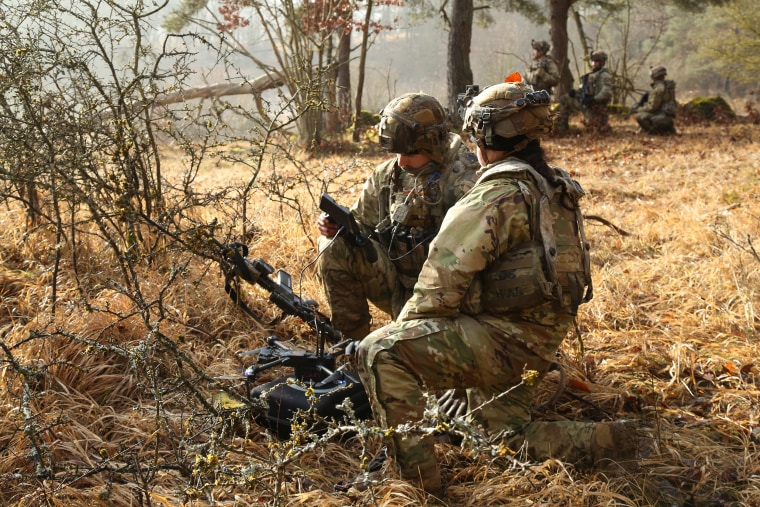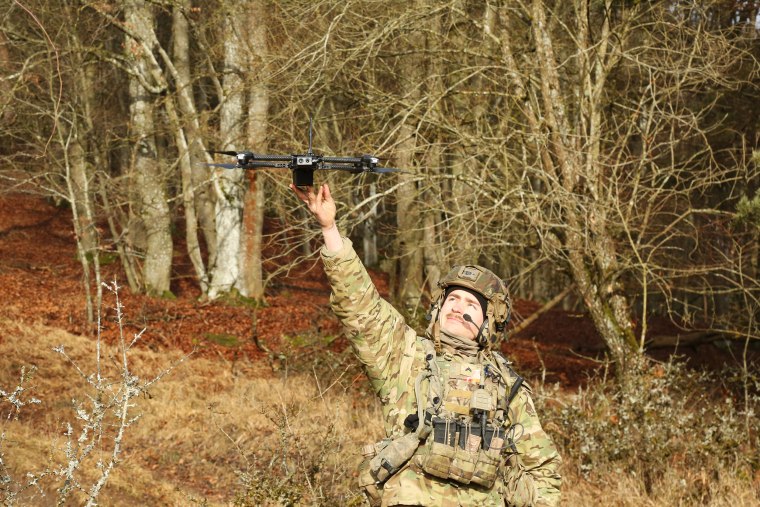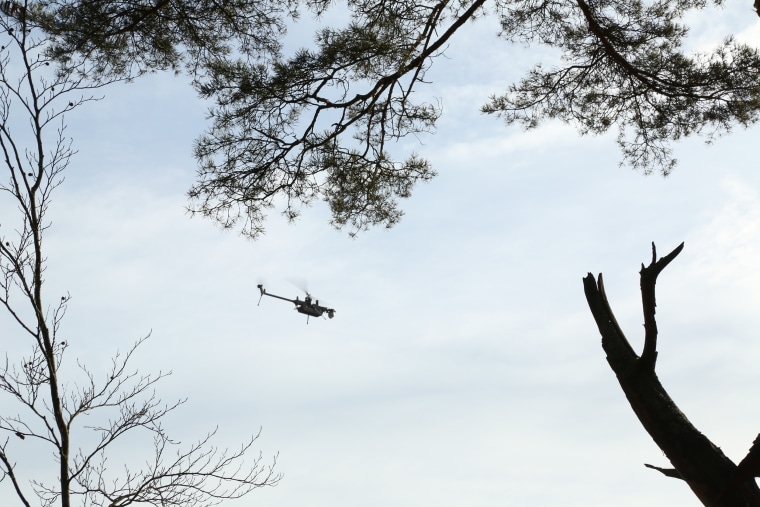
HOHENFELS, Germany — As the morning fog lifted over rolling, wooded hills in Bavaria, southeast Germany, a drone swept down to the grassy clearing and two U.S. infantrymen ran out of a nearby forest to change two long, black batteries.
Under the cover of trees nearby, another soldier was on a laptop monitoring the activity of that drone and several others, tracking an enemy vehicle several miles away.
Developed and tested using information from the real–life battlefield in Ukraine, the drone was one of several pieces of technology including light vehicles and updated communication devices that were being tested for the first time by the U.S. Army in Europe.

“These drones are definitely smarter than they’ve ever been,” 1st Lt. Jake Baumert told NBC News earlier this month as his new unmanned systems platoon experimented with the new equipment to figure out how best to use it in traditional infantry fighting.
“They have missions and they are semiautonomous, not fully autonomous, but you plan it, and you can direct it if you want to,” added the 28-year-old from Dallas.
Deploying multiple drones including short-range quadcopters similar to those available in stores to the public, his platoon observed the opposing force’s tactical vehicles. They also sent up larger unmanned aerial vehicles that flew semiautonomously.
As well as being able to start and land them with a click of a button on their laptop, operators could also hand control of the drones to other units hidden in dense forest several miles away, while the information they gathered could be shared instantly with colleagues or commanders.
“I think the biggest advantage is the technology that’s in the drone and its ability to give you data,” Baumert said.

Elsewhere, soldiers tested vehicles that seat more soldiers than traditional Humvees. Smaller and often more agile in steep terrain, they are easier to camouflage and are equipped with hybrid engines, making them quieter and less likely to be spotted by drones with thermal cameras.
Lessons learned during Ukraine’s three-year war with Russia and Israel’s fight with Hamas in Gaza had “really identified that we’ve got to get faster at staying competitive,” Sgt. Maj. of the Army Michael Weimer said in an interview late last month.
Experience garnered during Iran’s missile and drone attacks on Israel, as well as those by its Houthi proxy army in Yemen was also being taken into account, he added.
“The character of war is changing at a speed we’ve never seen before,” he said. “We’ve got to get faster at staying competitive with the technology that’s changing.”
Information from the battlefield was coming via several avenues in Ukraine, he said.
“Traditionally, we wouldn’t give such new technology to soldiers this early. Traditionally, we would grab a few soldiers, and we would allow them to use the gear, experiment with it, get some feedback from them, then go back, do some more research and development,” added Weimer. “What we’re doing here, because so much of this is commercial off the shelf, is we’re expediting our ability to learn.”

The lessons U.S. and NATO troops are learning from Ukraine and implementing in their training are game changers, according to Ed Arnold, a European security expert at the Royal United Services Institute, a London-based think tank.
“Using drones to spot targets is one of the most important things we have learned from Ukraine. As an example, using artillery strikes. There’s nowhere to hide on the battlefield,” he said in an interview earlier this month.
He added that the maritime capabilities were “probably more significant than the land capabilities,” because Ukraine’s military had been able to use marine drones to destroy Russian ships and infrastructure. This had allowed Ukraine to keep vital shipping lanes open so it could continue exporting critical products like grain.
The U.S. military had also learned a lot from the way Ukraine has defended parts of the Black Sea, he said.
Back on the training ground in Hohenfels, Col. Josh Glonek, the commander of the 3rd Brigade, 10th Mountain Division, said incorporating the new technology had dramatically reduced the time it took to make a firing decision after spotting an enemy.
This had gone from double digits to under two minutes, said the 43-year-old from Gordon, Wisconsin.
“The lessons that are coming out of Ukraine are ones that we are very rapidly adapting to and incorporating into our own training,” he said. “So it’s provided, I would say, a sense of urgency, not only for us, but for our NATO allies as well, to very rapidly modernize.”
Carlo Angerer reported from Hohenfels and Meagan Fitzgerald from London.






